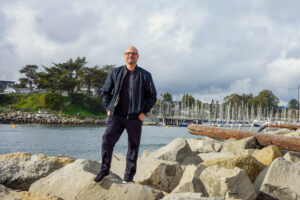I was excited to sit down at the IBM Global Summit in Nashville with Jeremy Gutsche, an innovation expert, award-winning author, “one of the most sought-after keynote speakers on the planet, and the founder of TrendHunter.com, the world’s #1 largest, most popular trend spotting website. In this interview we discuss how Jeremy looks at building communities around the world that helps to spot and translate the largest trends around the globe.
The following interview has also been transcribed below:
TRANSCRIPT
Bryan: Welcome back to the IBM Global Summit Conference here to the video series. I have Jeremy Gutsche from Trend Hunter. The Chief Trend Hunter. Is that right?
Jeremy: There you go. Why not?
Bryan: Can we go with Chief?
Jeremy: Why not make it fun? Chief Trend Hunter. It’s a much better title than CEO
Bryan: Great. Well we’re already having a blast here in the interview. We were talking a little bit before about what Trend Hunter does. I just wondered if you can give just a quick intro into what you were just telling me about that.
Jeremy: Sure. Well Trend Hunter’s story fits really well with Smarter Commerce which is why I’m excited to be here. Basically I was a guy who spent about 10 years in the world of Corporate Innovation and along the way I always found myself wanting to figure out what my business idea would be but I could never quite figure it out. So I started coding this website, Trend Hunter, where people from around the world would come to share their ideas. But pretty soon we had about 110,000 contributers, kind of like 6 stadiums of people looking for ideas for you. And the audience that comes to look at what we feature is about 40 million views a month. So if you think of the data, it’s a laboratory and effectively we think of it like a giant focus group evaluating all these new innovations. Instead of relying on what a guru used to tell you in the old school days, we look at what the power of the people can tell us about opportunity.
Bryan: That’s great. So tell me, how do you get 100,000+ people to participate? What’s the crowd source method to getting to that point?
Jeremy: The way that Trend Hunter works is it’s sort of like this campfire people are collected on where you’re talking about what’s new. These cutting edge ideas. So to contribute it would be part of it at that level to be a trend hunter it’s about the social currency of being that person in your social group that’s the first one in the know. Showcasing that you’re discovering these awesome new innovations and creative things.
Bryan: I love it.
Jeremy: Absolutely.
Bryan: One of my favorite books that kind of got me interested or continued along the way in my career was Faith Popcorn who was a trend person as well and she loved to predict things and help with focus groups to help predict things. Where are focus groups right now, or is it crowd sourced? I mean have focus groups gone away?
Jeremy: Well I think focus groups, surveys, interviews, they all teach you something and you can learn from it but a dangerous tool that’s happened over the last decade is the ability to micro-compare yourself against what your competitors are doing. And it’s so easy to benchmark that what happens is companies are replicating their competitors strategies. And I like to think about it like this: Whatever’s popular, is mainstream. So the things your competitor does that have already taken off, those are obvious to everyone in the marketplace. Cool is different than popular. Cool is something unique, cutting edge, that your consumers will talk about. So the pursuit of new opportunity is really not about what people are tweeting about today or what they’re searching about today, but it’s trying to find out what’s going to be big tomorrow. So effectively that’s what I’ve tried focusing on. Now Faith Popcorn, Malcolm Gladwell, these people sort of started that industry by trying to look into the future long ago. What I’m trying to do a little bit differently is use the power of the crowd to do the same thing in a more dot com kind of way.
Bryan: Tell me about one thing that you didn’t realize you’d stumble across in this process. You’re obviously working on something that’s different than anything else anyone’s doing right now. So it hadn’t been done before. So obviously you’re new to this. What did you figure out?
Jeremy: Well I guess the obvious thing was that my original goal was to try and find my own business idea and I thought someone, a global contributor from around the world, would submit an idea and that would be the business that would inspire me. But as it turned out, Trend Hunter took off. So that’s the most obvious thing. But in 2006-07 when things started getting going for Trend Hunter it was interesting because at the time if you rewind back, the world was enamored by bling. And there were five thousand dollar hamburgers and twenty thousand dollar martinis. And I always remember an example where we covered a hundred different items that were bling. One of them being Shu Uemura who is a maker of false eyelashes. They made diamond encrusted eyelashes for Madonna for ten thousand dollars and what was unique about it was that it wasn’t about the ten thousand dollars eyelashes, although you could get them in a variety of stores. It’s that people were aspiring to that, and the fifty-dollar version for teenage girls was available ubiquitously. So it was an example of how to look at a trend and try to capitalize on it. What I wasn’t expecting that was cool was to see that as 2007-08 moved on…in 2007 we wrote our first article about how bling bling was becoming boring and the power of the crowd was showing us less interest for flashy luxury. But at the time the stock markets still hadn’t crashed. So we started covering things like “Credit Crunch Couture” and “Do It Yourself Fashion” and all these things that would kind of tap into consumers being a little bit more cost conscious and by a year after those first reports coming out the S&P 500 had fallen in half. And so that’s when the financial analyst in me, which was my background, started thinking you know there’s something else here and what the power of the crowd can tell a person.
Bryan: So tell me how often is the crowd accurate versus nonaccurate now in your experience in predicting perhaps more the predictive outcomes.
Jeremy: Well I think the way that I try to look at it, is if you want to be doing remarkable innovation, what you need to look at is not the accuracy in a grand prediction which was the old way of thinking about it. The old way was to try and come up with something that will be your product a year or two from now. The new way is to look for all the pockets of opportunity. So I’ll give you an example of what I’m going to be talking about here at the Commerce Conference, Smarter Commerce Conference for IBM. If you go to fashion, I’ve had the opportunity to work with a number of awesome retailers like Victoria’s Secret, helping their CEO and teams to reinvent. But like most of the cutting edge people, they operate with about a one year schedule. So they’re already making what they’re working on a year from now. They’ll study, they’ll research, they’ll make ad campaigns and because they have a lot of creative flair that brand is going to do great. But not everyone can always rely on that creative flair. You can’t always consistently guarantee you’ll be on the edge. Now while most designers and fashionistas are in that year out realm, I’m going to tell you tomorrow about a guy named Emmanuel Ortega. Emmanuel, he’s a guy -77 years old. He wears the same blue outfit every single day. He’s a workaholic. He eats sandwiches from the same store every day. But the extra little thing about him is he happens to be worth seventy billion dollars. He’s the world’s third richest person but no one’s heard of him really because he doesn’t do interviews. The first picture of him ever found wasn’t until 1999, at which point he’s already 63 years old or something. And the interesting thing is his creation is a little different than the rest of the fashion world. Instead of taking 12 months to get his designs into the store, his designs for Zara take 14 days. And their designers sit in the front rooms of a store front or of a fashion show and they sketch designs on their iPads which are sent instantly to the little town in Spain where he works along with the people that actually fabricate the products. It’s not done in China, it’s got to be done fast. Within 14 days from that sketch, that design for perhaps a red dress is inside of 5000 Zara stores but only 5 dresses go to each store. And if you’re walking in that store and you look at the dress and the store keeper says, “Did you like it?” And you’ll say, “I don’t know, maybe not.” They’ll say “How come?” And you say “I don’t know I don’t like a dress with a collar.” Seems like it was innocent, seems like what happens in every other store. The difference is every single day in every single store the storekeeper writes down, dress 5562 didn’t like a collar. The designers who only saw it two weeks ago now have that info and the new dress, it’s going to be ready in two weeks. So this is the future. When I think about what IBM’s empowering and what Smarter Commerce can mean, I think that’s the sort of gold standard that’s pretty exciting and this is where the world’s going. So getting back to your initial question with Trend Hunter, am I trying to predict something that’s going to be right in a year or two? Well no, it happens that some of these things about the recession did line up, but what I’m actually trying to do is find all the opportunities that are existing now to help someone find that next big thing. And that’s what I find is a really inspiring challenge.
Bryan: Oh that’s great. Oh my gosh you know it’s the power of now. Things are happening now, not a year from now and we need to pay attention to all those things that are happening. And now how do you interpret data? How do you take that data that’s now raw, that’s now pulled together especially as an analyst, how are you taking that data and now saying okay let’s make these little decisions that might affect massive change.
Jeremy: Yeah I think where we’re at right now in the world is when we talk about data and analytics, there’s a lot of fascination with the cloud and big data and people are throwing these things around like big words.
Bryan: It’s been in every room here at the conference.
Jeremy: But it’s really what you can make of that. It’s about synthesizing through all of the noise. And I think that the conversation will start to shift over the next few years when people realize it’s not just data, it’s that you can make a lot of difference. And I remember at Capital One when I was running analytics in Canada, we were trying to push and introduce new techniques. New analytics techniques that would take us, a huge bank, one of the most successful banks in the world to the next level. And we were looking at a couple different techniques and I went down to our head status station and learned a little bit more about them. And what I did, he said “Well okay let’s start with this” and he pulls out this sort of handwritten piece of mathematic formula and he goes, “Here’s what we’re going to be learning today, and everything you’re going to learn which will make this bank billions if we do it right…well it will bring us up to the techniques discovered in about 1870.” And it just shows you that making sense of all the noise, it’s not easy. There’s a lot you can do and the power, the abilities are all out there but how we sort of pull insides from is the challenge. Hopefully tomorrow I’ll have some good ideas for the people in the crowd.
Bryan: I can’t wait. And your energy and your passion about what you guys are doing is so infectious and so exciting and I just wanted to give you some kudos and say thank you for doing what you do. It’s helping it drive things like this for what we’re talking about her at the conference. Great, so where can people find you online?
Jeremy: Well obviously TrendHunter.com, the world’s largest collection of cutting edge ideas has a lot of stuff but I made a separate link that has about five hundred bucks of free stuff for all the people that are part of IBM’s Smarter Commerce World and it’s url that is trendhunter.com/secret/ibm.
Bryan: Perfect. Well thank you again for joining us here at IBM Global Summit. Very nice to have you.
Jeremy: Nice to meet you.
Bryan: And thank you for joining us for another session here at the IBM Global Summit. We’ll see you soon.





